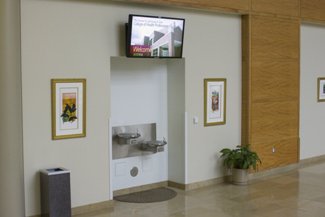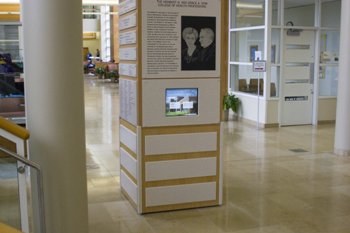Digital Signage Aids Staff, Patients, Visitors
 Healthcare facilities are competing more fiercely than ever in the struggle to attract patients and keep them loyal. There are a number of reasons for the increased competition such as increasing numbers of mergers and acquisitions, which have exaggerated the competitive landscape.
Healthcare facilities are competing more fiercely than ever in the struggle to attract patients and keep them loyal. There are a number of reasons for the increased competition such as increasing numbers of mergers and acquisitions, which have exaggerated the competitive landscape.
In addition, the stimulus bill has increased the pool of insured patients by the millions, and the rising population of aging baby boomers has dramatically increased the number of healthcare consumers.
Now, facilities are increasing their expenditure on marketing and advertising to connect with patients and promote their specialties, much like how others are doing so with their shoppable content online. Some well-known examples include Mayo Clinic, Cleveland Clinic, Johns Hopkins, Memorial Sloan-Kettering, and Massachusetts General Hospital. These and other hospitals and medical centers across the country are competing to establish themselves as the go-to place for particular diseases as more patient’s comparison shop for treatment.
Medical facilities are also spending more on capital improvements. Construction spending on healthcare projects has remained at historically high levels despite the recent economic downturn, approaching $50 billion in 2009, according to the U.S. Census Bureau. Analysts expect that amount to top $60 billion by 2013. At last, healthcare administrators have the additional income needed to make capital investments in their facilities and understand how important it is to do so if they want to remain competitive.
Investments, especially in the form of new technologies that will enhance the safety, efficiency and comfort for patients, are at the top of many facilities’ priority lists. Digital signage technology is one growing technology that meets all of these goals.
Why Digital Signage in Hospitals?
Digital signage is a cost-efficient way to bring staff – the heart of the facility and the face of the brand – front and center. Whilst many people focus on Danger signage and other vital health and safety equipment, this can play a vital role too. More than equipment and medication, hospitals rely on their employees who are the hospital’s brand. It’s a real-life social network of staff. Digital signage enables a facility to cost-effectively extend that social network to patients and visitors who are experiencing the hospital in person.
 That’s how the Holzer Clinic is leveraging digital signage in its facilities. Located in the Southeast Ohio River Valley, Holzer Clinic treats more than half a million healthcare consumers each year throughout nine different locations. To fully serve patients, extend the presence of its caring staff and communicate its brand, the clinic needed an efficient way to cross-promote its 20-plus specialties and more than 18 healthcare services.
That’s how the Holzer Clinic is leveraging digital signage in its facilities. Located in the Southeast Ohio River Valley, Holzer Clinic treats more than half a million healthcare consumers each year throughout nine different locations. To fully serve patients, extend the presence of its caring staff and communicate its brand, the clinic needed an efficient way to cross-promote its 20-plus specialties and more than 18 healthcare services.Hammond Communications Group, a digital media company, designed a digital signage network called Holzer Clinical TV. Today, it consists of 25 screens strategically positioned in waiting areas in each of the clinic’s locations. Each screen is divided into three zones that display live TV cable feeds, a rich media zone dedicated to clinic messages, and locally controlled scrolling text messages. The entire network is centrally controlled to reduce staff burden and maintain quality control.
Digital signage applications like Holzer Clinical TV are being implemented throughout healthcare facilities across the U.S. and Europe. In all cases, these networks are helping improve patient care and overall operational efficiencies. From helping patients quickly navigate through the maze of halls in a hospital and easing the frustration of excessive wait times for nervous visitors to educating employees and patients of new health concerns, digital signage presents an opportunity to alleviate many of the challenges to achieving high patient satisfaction. By bringing limited staff to the forefront through digital signage technology, medical facilities can enhance their relationship with patients and overall brand.
Listed below are just a few of the ways this promising technology is being leveraged.
Communication Signs in Waiting Areas
Digital signage displays in waiting areas and lobbies make the wait time more enjoyable for patients and visitors alike. Facilities can use these screens to display an always up-to-date mix of news, health and wellness services information, educational information such as the importance of handwashing, gift shop ads, cafeteria menus, and promotional content. In larger facilities, the content on individual screens can be tailored to each department, for example, showing information on childproofing the home in the hospital waiting area for new parents. When appropriate, airtime can be used to promote higher-margin services such as cosmetic surgery.
These signs enhance communications in other areas, too. One facility recently included digital signage screens outside its parking garage elevators and throughout long corridors. Another large teaching hospital with an impressive research arm uses digital signs to communicate upcoming educational seminars, events or study breakthroughs that will be presented in its connected conference center. Additionally, digital signage helps to educate anxious patients about what it’s like to experience an MRI.
Private TV Networks in Patient Rooms
Hospitals can provide patients with additional programming choices in their rooms using a centralized media player that connects to existing TVs across the facility. This approach is similar to a waiting area display, but the programming loop is optimized for longer content. Because the administrators maintain control of the programming, screen time can be used to display patient success stories, inspirational messages, partner advertising, health and wellness services, or any other selected content.
Touch Screen Directories and Wayfinding Systems
Wayfinding kiosks help patients navigate the facility without having to ask for directions. This improves patients’ satisfaction and increases the chance that they will arrive at their appointments on time. Hospital maps can be updated remotely, allowing administrators to manage an entire network of hospital directory wayfinding screens from a central location. Interactive “you are here” touch screens make it even easier for patients and visitors to find their way.
Digital Menu Boards
Hospitals and large clinics that provide cafeteria services benefit from digital menu boards, which enable staff to quickly and easily update frequently changing menu choices along with nutritional and caloric information. The digital menu boards can be changed as often as necessary with just the stroke of a few keys and can be used to advertise specials or provide other information in a ticker-tape style presentation running along the bottom of the screen.
Patient Registration and Check-In Kiosks
Allow patients to use self-service kiosks to fill out new patient profiles, update their insurance and contact info, and schedule future appointments with health care providers using digital signage check-in kiosks. If this kind of technology sounds interesting, you can look here to see how a self-service kiosk or POS system can benefit the speed of service and experience of their users in any given business, industry, or application. Hospital kiosks can also integrate with larger self-service initiatives and patient registration systems such as those that provide web-based appointment requests and insurance claims.
Self-service touch screens improve overall efficiency, alleviate staff burden and reduce wait times for patients. This is especially important for facilities that are open 24 hours a day but have periods when the information desk is not fully manned.
Staff Training
Efficiently and consistently communicate new policies, updated safety procedures, new treatments, and more through digital signs positioned in employee break rooms and other common areas throughout the facility. The staff becomes better informed and, therefore, more empowered to provide better service to patients.
A Bright Future
Digital signage technology in healthcare settings offers endless possibilities. One application on the horizon is to sync website content with content displayed on a hospital’s digital signage screens. For example, a mid-Atlantic hospital hopes to incorporate news from its website, which is updated daily, as one of the primary content drivers for its future digital signage network.
Another potential application is to integrate the digital signage system with a healthcare facility’s patient security system so that if a patient goes missing, it would automatically trigger an alert throughout the digital signage network. And this is really just the beginning.
“Healthcare is ripe for digital signage,” says Dean Reverman, Director of Sales and Marketing at Hammond Communications Group. “Over the past decade, we’ve noticed that healthcare organizations are growing increasingly more marketing savvy and more concerned with finding better ways to communicate at the point of care. In many cases today, once the patient or visitor comes into the facility, communication falls apart. It’s left to rudimentary posters and pamphlets, which do not dynamically communicate the facilities’ vision or adequately represent its staff. In contrast, digital signage technology captures patients’ attention, and then enables interactive, lively communications, resulting in improved patient relations.”
Tom Nix is vice president of the Americas and Oceania for Scala Inc. Through his in-depth knowledge of digital signage technology, Tom has been instrumental in growing the digital signage market and educating various industries, including healthcare, about the benefits of this innovative technology.
